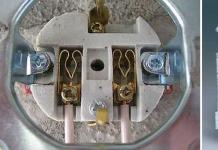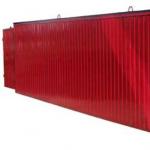In order for the cucumber harvest to meet expectations, you need to monitor the possible appearance of pests on the site, protecting the crops. Only high-quality processing of cucumbers will protect them from the main enemies and prevent the development of diseases affecting them. What pests are most often tempted by cucumbers and what methods of dealing with them are known? More on that below.
A dangerous enemy - aphid: how to deal with it
You can notice the melon aphid on the plant when examining the leaves - the insect camouflages itself on the back of the leaf. If melon aphids have settled on cucumbers, then it will not be difficult to notice this by the fallen leaves and a sharp decrease in the level of the crop, up to the death of the plant in weather with a high level of humidity.
The insect pest can be recognized by the characteristic oval shape of the body of a dark green color up to 2 mm long. If these are females, then they are wingless, if larvae, then variants of individuals with wings and without green or yellow are possible. Pests breed in the spring when the air temperature reaches 12 degrees above zero. Each adult gnaws cucumber leaves, stems, flowers. Up to 20 generations can appear in one season.
In order for the protection of cucumbers from melon aphids to give a result, you need to know about the methods applicable in pest control. These include:
- Treatment of plants with water and soapy water or clean water under pressure (suitable for a small number of insects).
- Treatment with tincture of onion peel or ash solution with an interval of 5 days.
- Burning yellow cucumber lashes in case of mass damage with the treatment of the remaining plants with sulfur powder or karbofos.
- Treatment with the drug "Iskra" or "Fitoverm" with protection with plastic wrap for a day.
- Planting plants that can scare away the pest: mint, mustard, garlic, coriander and others.
- Settlement on the site of natural enemies of aphids - ladybugs.
In order to not have to deal with pests often, it is important to comply with the requirements for fertilizing cucumbers, watering, and regularly weeding the soil, getting rid of weeds.

Spider mite - what is dangerous and how to get rid of it?
Spider mites on cucumbers can be found more often than any other insect pests. It affects crops regardless of the region and climate where they are grown, both in open areas and in greenhouses. The mite hooks on the underside of the leaf of the culture, drinking the juice and wrapping it in cobwebs. The result of such a neighborhood is the death of the leaf, and behind it the whole plant.
Such pests of cucumbers (photo can be found below), like spider mites, require a serious approach to destruction. Proven insecticides will do, as well as, in the absence of the possibility of using them, a soapy solution for treating plants.
As an option, it is worth considering the settlement of the site with the natural enemy of the tick - phytoseiulus, which will cope with the eggs laid by females. It needs to be restocked every few weeks.

Slugs - what harm do they do and how to exterminate?
At first glance, completely harmless slugs can actually cause the development of cucumber leaf disease and, as a result, reduce the amount of the crop and its quality level. It is the slugs that are carriers of fungal spores and a direct threat to infection of the culture with powdery mildew or gray rot.
Slugs appear in areas with favorable conditions for them:
- humid climate;
- an abundance of weeds;
- an abundance of voids.
So that cucumber pests do not have time to harm them, it is better to plant crops in early spring, giving them the opportunity to get stronger. After harvesting, it is important to remove all vegetation that pests can use as a food source.

If slugs appeared on the site and are aimed at destroying cucumbers, you can deal with them in the following ways:
- Collect by hand with tweezers.
- Arrange grooves in the area that complicate the movement of insects.
- Use proven chemicals - metaldehyde, fluffy lime, iron sulfate and others.
- Involve frogs, toads, and lizards to naturally exterminate pests.
- Create favorable conditions for nesting birds of prey - starlings, thrushes, magpies, etc.
Compliance with the rules regarding the care of the site and the timely planting of crops will become a kind of guarantee that diseases and pests of cucumbers will not violate plans for a seasonal harvest.
Who are bears and why are they dangerous?
A large number of enemies of cucumbers are replenished by bears. We are talking about fairly large insects up to 5 cm in length. Harm is caused by both adults and larvae. Medvedki gnaw through the plant in the area of \u200b\u200bthe trunk and root system, multiply rapidly and are able to fill the entire garden with themselves if cucumbers and other crops are not processed in a timely manner. You can fight bears in the following ways:
- Traps with manure on boards or plywood.
- Traps baited with a mixture of hot peppers, water and honey.
- Planting an alder that repels pests.
- Ready preparations - "Medvedko-s".
The latter option will require certain costs, but is a proven method, since insects die after exposure to the drug in just 2-3 hours.

How to deal with thrips on cucumbers?
If thrips appeared on the site - a small pest that winters in the remains of plants and is capable of producing up to 7 generations of new individuals per season, then urgent measures must be taken. Both adults and larvae are extremely dangerous for vegetable crops, in particular cucumbers. Pests suck juices from plants, as a result of which they change color, and eventually die.
You need to deal with thrips as follows:
- Carefully remove plant debris after harvest.
- Dig up the soil in autumn and spring.
- Disinfect the land on the site after harvesting with karbofos and similar means.
- Do not forget to treat the seedlings with an infusion of hot pepper and water, infused for a day with the addition of laundry soap.
Using solutions for treating plants, both purchased and prepared on their own, one must not forget about repeating the procedure with an interval of no more than 5 days.

Cucumber mosquito - how does it affect plants and how to display it?
Listing insects from the category of pests of cucumber seedlings, it is worth mentioning the cucumber mosquito. Most often it appears on plants affected by any disease. Insects pose a serious threat to the roots and stem part of the cucumber. Not only adults are considered dangerous, but also mosquito larvae that live in humus or manure.
Invasion of pests is noted in the middle of spring. It is at this time that females lay eggs of the order of 300 pieces at a time.
The larvae easily penetrate the root system of plants, dotting the stem with numerous passages.
In this case, the protection of cucumbers will be based on the use of spray preparations. One of the proven options is Iskra. The solution is prepared according to the instructions from one tablet diluted in 10 liters of water. This amount of solution is enough to process up to 100 m2 of land.
Additionally, it will be necessary to carry out thermal sterilization of the soil.

Wireworm - how it harms cucumbers, methods of struggle
The wireworm is the larva of the click beetle. Its length is 5 cm, its habitat is cracks in the ground on the site. Beetles from the larvae will appear no earlier than in 3 years, until this moment the larvae actively infect the stems of cucumbers, feeding on them from the inside.
An effective wireworm protection scheme is built primarily on the mechanical method - manual collection of pests, followed by digging up the earth. To prevent re-infection, after harvesting, all traces of plants are removed, liming and mineralization of the soil are carried out.
Specialized chemicals-insecticides will allow you to get rid of the larvae in large numbers. Proven options are Bazudin, Diazinon and Calypso.

Gall nematode - a pest worm and methods of dealing with it
What pests and diseases of cucumbers in the greenhouse are most common? One of the worst enemies of greenhouse crops is the gall nematode. Only 1.5 mm long, it penetrates the root system of plants, settles in the tissues and, releasing toxins, leads to the formation of swellings and growths in which larvae appear and grow.
Affected plants grow worse, bear less fruit. The solution to the problem in greenhouses can be the replacement of the affected soil (at least 50 cm) with a new one, or the cultivation of the land with steam.

Sprout fly and whitefly - how to defeat and protect cucumbers?
Sprout flies reach a length of no more than 5 mm, while getting to the site, they lay eggs in the soil, from which larger larvae will appear over time. It is they that infect crops, affecting seeds, seedlings and stems from the inside.
The larvae eat the plant for two weeks, after which they pupate and give rise to a new generation. In one season, several generations of pests appear in this way, negatively affecting the yield of cucumbers.
To prevent the sprout fly from harming crops, the following preventive measures should be taken:
- Use only ready-made compost in the greenhouse.
- Loosen the soil before use, plant the seeds after germination to a shallow depth.
- Use seed growth promoters.
- Remove all crop and plant residues after harvesting cucumbers.

Another enemy of cucumbers is the barely noticeable white midge whitefly. The insect appears in the second half of summer, displays larvae on the lower part of the leaf of the plant, which leads to their withering. Tobacco dust, as well as red pepper with water, will help get rid of the pest. Of the proven drugs, it is worth highlighting "Phosbecid" and "Confidor".
Cucumber Beetles - Rare but Dangerous Enemies
An overseas guest - the cucumber beetle is extremely dangerous for cucumbers, but is rarely found in the country. It is distinguished by stripes or spots of bright color on the back. The insect damages crops more often in the form of larvae. Plants turn yellow at first, and eventually fade. In addition, pests are carriers of diseases.
You need to fight them by disinfecting the soil with a solution of potassium permanganate, or by a mechanical method, followed by the destruction of beetles.
What other problems are there?
In addition to numerous diseases and pests, cucumbers may not be born due to a fungal infection that affects the soil. You can detect infection if the earth in the greenhouse is covered with a white coating - in the form of mold. The solution to the problem in this case will be drugs: Fundazol, Hom, Fitosporin. The preparations are added to the water during irrigation, after which the soil is loosened, leaving it to dry completely.
In conclusion, we note that it is realistic to grow healthy vegetables, especially if they are rare medicinal orange cucumbers, but only if the recommendations for soil and plant care with seasonal treatment and disease prevention are followed.
Here you can learn about which cucumber diseases cause the most damage to plants, and how to protect plants from infections. After reviewing the photo and description of cucumber diseases, you will be able to recognize the disease in a timely manner and take the necessary control measures.
Diseases of cucumbers in the greenhouse in the photo
Downy mildew (downy mildew). A widespread fungal disease of cucumbers, which is the main cause of premature death of summer crops of cucumbers, also affects cucumbers in greenhouses.
On the affected leaves, rounded or angular yellow spots appear, on the underside of which a grayish-purple coating of conidial sporulation of the fungus develops.
As can be seen in the photo, with this disease of cucumbers, the affected tissue becomes brittle and crumbles easily, the leaves wrinkle and fall off:
 Downy mildew (peronosporosis) of cucumbers in the photo
Downy mildew (peronosporosis) of cucumbers in the photo  With this cucumber disease, the affected leaf tissue shrivels and falls off (photo)
With this cucumber disease, the affected leaf tissue shrivels and falls off (photo)
In closed ground conditions with high humidity, leaves affected by downy mildew rot.
During the summer, the fungus spreads by conidia, and then spores are formed in the affected tissues, in the form of which it hibernates. Fog, dew and moderate temperature (+16...+22°С) contribute to the development of the disease. The source of the disease is the remains of diseased plants.
To combat this disease of cucumbers, it is necessary to observe the alternation of crops, carefully clean and destroy plant debris. In greenhouses - it is necessary to maintain the optimum temperature (above +24 ° C) and humidity (within 80-90%).
For the prevention of peronosporosis (downy mildew), Profit Gold is used. When the first signs of the disease appear before fruiting, cucumbers are sprayed with one of the copper-containing preparations (Bordeaux liquid, Abiga Peak, Oxyhom, Khom, Ordan, etc.). Repeated treatments in case of resumption of the disease during the fruiting period are carried out with biological preparations Fitosporin-M, Alirin-B. Preparations for protection against downy mildew must be alternated. As you can see, it is not so difficult to fight this disease, the main thing is to recognize the disease in time and prevent its spread.

Powdery mildew in the photo. Fungal disease of cucumbers
Powdery mildew. Also a fungal disease. Initially, the disease appears on the upper side of the leaves in the form of individual white powdery spots, covered with a bloom of the mycelium of the pathogen. The spots are getting bigger; merging, they cover the entire upper side of the leaf.
With this disease of cucumbers in the open field and greenhouses, a powdery coating appears on the underside of the leaves, as well as on the petioles. Severely affected leaves dry up. In closed ground, the disease is also noted on fruits.
During the season, the powdery mildew pathogen is spread by spores with an incubation period of 3-4 days. In winter, the fungus survives on infected post-harvest residues.
The disease can reduce yields in open fields by up to 30% and in greenhouses by up to 60%.
In the treatment of this cucumber disease, plants can be sprayed with Topaz, and during the harvest period with colloidal gray, Thiovit Jet, Fitosporin-M or Alirin-B when the first signs of powdery mildew appear, and then at intervals of 7- 10 days.

Cladosporiosis (olive brown spot). A fungal disease that develops on cucumbers everywhere in open and closed ground. Cucumber fruits are mainly affected, but leaves and stems are sometimes affected. The first signs of cladosporiosis on fruits are small watery spots that quickly increase in size, reaching a diameter of 5 mm; the skin of the fruit cracks, quickly hardening gelatinous drops appear on the surface of the spot. At high humidity, the spots become covered with a black-green velvety coating.
Pay attention to the photo - with this disease of cucumbers in the open field and in the greenhouse, diseased fruits are bent:
 Cladosporiosis of cucumbers in the photo
Cladosporiosis of cucumbers in the photo  With Cladosporiosis of cucumbers, diseased fruits are bent (photo)
With Cladosporiosis of cucumbers, diseased fruits are bent (photo)
Scattered small brown spots surrounded by a yellowish border appear on leaves affected by olive brown spotting by the beginning of fruiting. The raid on them is dim, weak. On old leaves, the affected tissue falls out. On the stems, the disease manifests itself in the form of dry ulcers.
The causative agent of the disease develops at wide temperature ranges (+5...+30°C) and relative air humidity (from 35 to 100%), but a strong development of the disease is facilitated by a decrease in temperature at night to +16...+18°C at relative air humidity over 85%.
Measures to combat olive brown spotting include maintaining the optimal regime of temperature and humidity. If necessary, spraying plants with copper-containing preparations, as well as against peronosporosis.
These photos show cucumber diseases and how to treat them:

Root rot. The disease mainly affects cucumbers in greenhouses, it also occurs on plants in the open field. The disease of root rot is usually preceded by the weakening of plants under the influence of adverse external conditions.
On cucumbers in greenhouses, the disease manifests itself in the fact that the leaves, starting from the bottom, gradually turn yellow. Gradually, the plants wither. Browning of the bark is noticeable on the lower part of the stem and roots.
Look at the photo - with this disease, the stem is crushed in cucumbers in greenhouses.
 Root rot (photo). The disease mainly affects cucumbers in greenhouses.
Root rot (photo). The disease mainly affects cucumbers in greenhouses.  With the disease "root rot" in cucumbers in greenhouses, the stem is crushed
With the disease "root rot" in cucumbers in greenhouses, the stem is crushed
The disease usually occurs as a result of a decrease in soil temperature or an excessively high concentration of minerals, as well as when watering with cold water. Lowering the air temperature in greenhouses to +17...+18°C contributes to the development of the disease.
The disease is more pronounced when sunny weather follows a long period of cloudy weather. The focal occurrence of rot is often observed in those places where the roof of the greenhouse leaks.
Similar signs of the disease are observed in plants in the open field, often after watering or heavy rain. At first, the leaves turn slightly yellow and tie. At the same time, the stem and roots have an outwardly healthy appearance, but there are no root hairs on the roots.
Here you can see a selection of photos of diseases and pests of cucumbers in greenhouses and open ground:
 Fusarium wilt of cucumbers in the photo
Fusarium wilt of cucumbers in the photo  Withering with Fusarium in the photo
Withering with Fusarium in the photo
Fusarium wilt. On the affected seedlings, the cotyledons wither or the lower part of the stem rots, as a result of which there is a mass death of seedlings. On adult plants, individual lashes first wither, and then the whole plant dies, often having a green color.
The causative agent of Fusarium wilt remains in the soil for a long time, and can also be found in infected seeds. It penetrates into the plant through young cells of root tissues, root hairs, grows into the tissues of the root neck; through wounds formed on individual lashes during pinching and other work. Inside plants, the mycelium of the fungus spreads mainly through tissue cells and blood vessels.
In the fight against root rot and Fusarium wilt, strict adherence to crop rotation, careful collection and removal of plant residues is necessary. The introduction of organic and mineral fertilizers, plant nutrition during the growing season, the destruction of the soil crust - after each watering, especially in the first period of growth.
Phosphorus-potassium fertilizers and wood ash reduce the intensity of the development of Fusarium wilt.
It is also necessary to disinfect the seeds by soaking them before sowing in the Fitosporin solution for 1-2 hours. When seedlings appear and during the growing season, water the plants with Gliocladin.
Heat and high humidity in a greenhouse is a dangerous combination for succulent stems and fruits, referring to disease-causing fungal spores.
 Gray rot of cucumbers in the photo
Gray rot of cucumbers in the photo  Botrytis cucumbers in the photo
Botrytis cucumbers in the photo
Gray rot (Botrytis). Cucumbers are mainly affected by it in greenhouses. The disease develops on various organs of the plant. This fungal disease causes especially significant damage by affecting the fruits.
It is possible to prevent large losses from gray rot, while observing the rotation of crops and maintaining the optimum temperature (not lower than +18 C) and air humidity (within 90%) in the greenhouse. It is necessary to remove rotten fruits and heavily affected plants from it.
Angular spotting (bacteriosis). The further development of the disease will be restrained by the biological preparation "Gamair".
To protect cucumbers from diseases and pests, you should not:
- Overfeed the plants with nitrogen so that the stems and leaves are not soft and thin.
- Planting plants too densely: this makes it difficult for air to reach them. Damp stagnant air and tightness contribute to the development of diseases.
- Create a stale, stuffy atmosphere in greenhouses and greenhouses. Avoid cold drafts in winter. When ventilating, open windows on the leeward side.
- Injure plants and fruits, this opens up easy access to pathogens.
- Leave cucumber fruits affected by diseases and pests on the plant - destroy them immediately.
Pests of cucumbers in the open field and greenhouse, measures to combat them
 Aphids in the photo
Aphids in the photo  Aphids on cucumbers (photo)
Aphids on cucumbers (photo)
Aphids are one of the most common and dangerous pests of cucumbers. It appears on young plants (at the stage of 3-4 leaves), and therefore the harm from it is especially noticeable. The leaves inhabited by aphids shrivel and curl, the growth of the shoot stops, the plant dies. With a later development of aphids under the influence of a pest, a curvature of the shoots, drying of flowers and ovaries is observed. These pests of cucumbers in the open field excrete polluting plants with abundant sticky sweet excrement, on which sooty fungi settle, which also aggravates the condition of cucumbers.
Aphids are quite large, up to 2 mm, clearly visible to the naked eye, black in mass. During the season, it develops in 15-20 generations (almost constantly there is a hatching of more and more new pest individuals). Moderate and humid weather favors the rapid reproduction of aphids.
Adult aphids overwinter on the leaves of weeds, most often on the shepherd's purse. In the spring they feed on weeds, later they fly to cucumbers. Aphid females are viviparous, their average fecundity is 25-60 larvae.
In the fight against aphids, as soon as it appears on the plants and before the fruiting of cucumbers, use spraying with one of the preparations (“Iskra-M”, “Iskra Zolotaya”, “Spark Double Effect”, “Confidor” or “Commander”). With repeated spraying, the preparations must be alternated so that the pest does not get used to them.
During the fruiting period, only biological preparations with a waiting period of 1-2 days can be used against aphids (Iskra Bio, Akarin, Fitoverm, Agravertin).
 Spider mite in the photo
Spider mite in the photo  Spider mite on cucumber (photo)
Spider mite on cucumber (photo)
The spider mite also causes severe damage to cucumber plants. A tick appears especially often if the air in the greenhouse is dry, this cucumber pest leaves light yellow spots visible to the naked eye in the form of injections on the underside of the leaves. If such spots are found, the plants are sprayed with garden or colloidal sulfur, you can use Thiovit Jet. Spraying is repeated after 7-8 days. During the application of sulfur-containing preparations, do not water the plants with sprinkling, so as not to wash them off the leaves. Sulfur preparations will also help cucumbers in open ground, where the spider mite colonizes plants in large numbers in July, August, when the heat is over +30 ° C at low relative humidity - 35-45%.
Of the biological preparations against spider mites, Bitoxibacillin and biological preparations recommended against aphids give a good effect.
Radishes planted between cucumbers and tomatoes repel leaf beetles and spider mites.
 Miners in the photo
Miners in the photo  Miners on cucumber leaves (photo)
Miners on cucumber leaves (photo)
Miners are pests that infect cucumbers in the open field during the fruiting period. With a large number of pests, use biological preparations, as against aphids.
What are the pests of cucumbers and how to get rid of them in simple and affordable ways. It seems that pest control is endless. Russia is a country where, during the period of planting and growing cucumbers, the climate is hot and arid. He is loved by various pests that actively reproduce and show their activity at high temperatures.
Owners of suburban areas spend a lot of time and effort to care for cucumbers. This process is not easy, but it cannot be avoided if the desire to get a healthy harvest is at stake.
This article will focus on methods of control and preventive measures that are carried out in greenhouse conditions, and in open ground conditions, when growing cucumbers.
Melon aphid on cucumbers - how to deal with aphids on cucumbers
- Description of the cucumber pest
The aphid is considered the most formidable pest, since it first eats the flowers, and then the whole plant as a whole, including the shoots. Since the activity of aphids occurs on the plant, cucumbers die.
The activity of this insect comes in the middle of summer. It reproduces at a fast pace. After a few days, the reverse side of the leaf facing the ground is exposed to infection. Flowers and ovaries are also infected.
- How to liquidate
It is important to ensure that there is no grass on the site. After harvesting, it is necessary to remove all the remains of plants completely, leaving nothing, and then burn them. This is due to the fact that aphids can migrate from grass to cucumbers.
In the case when the insect was noticed, prepare a mixture:
- Fill the bucket with 10 liters of water (the water should have a temperature of about 60 degrees).
- Capsicum is taken - 30 g. It must be finely chopped. If this pepper is not available, replace it with dry ground red pepper in the amount of 10 g.
- Take tobacco dust in the amount of 200 g.
- The components are mixed in a bucket of water.
- The solution is infused for 1 day.
- Then it is stirred.
- Filter.
- It is necessary to add 4 teaspoons of burnt wood ash and liquid soap to the mixture.
During the treatment of plants with this solution, 2 liters are taken for each square meter of the cultivated area.
Based on these calculations, it turns out that this bucket is only enough for 5 square meters of land. If the area planted with cucumbers is larger, then more solution should be taken. Repeat this procedure after 7 days.
No less effective will be the use of such a solution:
- Take a 10 liter bucket of hot water.
- Add 1 cup of burnt wood ash there.
- Also add 4 teaspoons of liquid soap
- Insist 24 hours.
- Spray, as in the first option.
Advice! The weather during this procedure should be calm, without wind. The best time to do this is in the evening.
To destroy aphids, they use an equally effective remedy - a solution of karbofos. In a 10-liter bucket, with warm water, dilute 1 or 2 tablespoons. this drug.
If the solution has an increased concentration, they are treated with tracks and films in greenhouses. When the concentration is weak - directly cucumbers. The processing process is best done in the 2nd half of the day, when the sun is not so intensely scorching.
Photo: Melon aphid on cucumbers. An oblong green rounded insect. The aphid sucks the juices from the leaves, and with a large population of the plant and terminal stemsWhen procedures related to spraying are carried out, after they are completed, there should be no open windows, transoms, or doors. You can fight aphids with the help of insecticidal infusions.
For this you can use: henbane, garlic, dope, onion, etc. All the solutions below are made in 10 liters of water:
- Henbane (leaves and roots) are needed in the amount of 1.000 g dry, or 500 g fresh. Insist for 15 hours.
- Dry mustard in the amount of 1.000 g insist 24 hours.
- Fresh dandelion leaves - 250 g (or 330 g of finely chopped roots of this plant) insist for 2 hours.
- Add 0.5 tbsp. pepper, mustard.
- Potato tops - 1.000 g, red pepper (ground) - 10 g. These components are insisted for 4 hours, and are urgently applied.
- Onion (1 cup) finely chopped, or passed through a meat grinder. Add 2 tsp. alkalis. Insist for 3 hours. Filter.
Important: before you start using these infusions, add 2 or 4 tsp to them. liquid soap.
Spider mite on cucumbers in the greenhouse and open field
- What are the characteristics of an insect?
If cucumbers have been infected with a spider mite, the following signs may indicate this:

Nadezhda Nikolaevna, 49 years old
- the appearance of dots of light shades (if the lesion is serious, these will already be spots) on the back of the sheet;
- a thin cobweb appeared on the plant;
- growth has become slower;
The leaves have started to turn yellow.
- Methods and actions for the destruction of the pest
What should the owner of the garden or plot do in order to eliminate the spider mite?
Activities that bring good results:
It is necessary before planting seeds, be sure to dig up the ground. This is important, since most harmful insects wait out the winter in the upper layers of the soil.
The spider mite first shows its activity while on the weeds. So that he does not get over to cucumbers, they must be cleaned regularly.
It is advisable to inspect plants as often as possible. In the case when the affected leaves are found, they are removed and burned.
We need to change landing sites. You can, for example, next year, plant cabbage or tomatoes in place of cucumbers. As soon as the spider mite has been detected, the sites of infection are treated with biological preparations.
- How to destroy a spider mite in a greenhouse
Those plants that grow in greenhouses are more at risk than others of becoming infected with a spider mite. It is in the greenhouse that the most beneficial conditions for the life of this harmful insect are: the temperature is from 30 degrees, the humidity is not very high.
 Photo: Spider mite. Ticks are fertile - several generations per season. The female lays one and a half hundred eggs.
Photo: Spider mite. Ticks are fertile - several generations per season. The female lays one and a half hundred eggs. Methods for the destruction of spider mites on cucumbers in greenhouse conditions:
- If you create a humidity level of more than 60%, the pest will obviously not like it. Keeping the humidity level around 85% in the greenhouse is a good preventive measure to prevent insect activity. If a web appeared on cucumbers, what should I do?
- When cucumbers are grown in a greenhouse, it makes sense to include in the main actions aimed at combating spider mites such as
- Carrying out fumigation of the entire greenhouse in the autumn, as soon as the entire crop has been harvested, as well as in the spring before sowing. It is necessary to ensure complete tightness.
- As soon as the crop is harvested, it is necessary to remove the top layer of soil.
- With the help of a gas burner, it is necessary to cut the trellis.
- Fertilize the soil with mixtures containing phosphorus.
Insectoacaricides, as well as acaricides, are those drugs with which they destroy the spider mite. Today there are no systems that protect against these means so that they do not negatively affect a person. That is why it is dangerously unsafe to use such remedies.
Gardeners noticed that excellent results after application were shown by means of intestinal contact action. Cucumbers are processed with them several times. Everything depends on the temperature. The higher its value, the more often it is necessary to process plants.

The most effective drugs aimed at the destruction of the spider mite are:
- Spark - Bio.
- Phytoferm.
- Karbofos.
- Bitoxibacillin.
Note to summer residents: it is advisable to carry out work related to the processing of cucumbers with preparations in the evening so that the sun does not burn. Then the chemicals will not have time to evaporate, and eliminate the harmful insect.
If you don't feel like messing around with chemicals, there's a harmless way to save your cucumbers. With the help of the phytosailus mite, you can get rid of the spider mite. You need to take a predator, place it nearby near the infected places. The phytosailus mite will destroy the eggs of the pest. To achieve the maximum effect, the tick is colonized every 21 days.
Summer residents and gardeners consider the following to be quite popular folk methods of dealing with spider mites:
- It is necessary to spray the cucumbers with a solution of soap;
- It is necessary to plant flowering plants;
- Planted on the site mushroom entomophthora Adjarian.
Greenhouse whitefly: signs and pest control measures
- Signs by which the whitefly is recognized
If suddenly the owner of the greenhouse noticed a tiny white midge, it could be a whitefly. It also comes in yellow or grey. It goes through the following stages of development: larva - nymph - adult - imago.
Throughout this period, she needs the juice of plants for her life. To get it, the insect makes punctures in a juicy young leaf.
An adult insect in length reaches no more than one and a half millimeters. The difficulty lies in the intensive reproduction of the whitefly. One individual lays more than 100 eggs. After a week or two, a huge number of children of a harmful insect are born.
A greenhouse is a place that is 100% suitable for whitefly activity. The air is warm here, the humidity just the way she likes it.
What else is needed in order to multiply rapidly? If the air temperature is high in the greenhouse, then the larva of a small pest will very quickly become an adult. She, in turn, will be able to fly and lay many eggs on the leaves of cucumbers.
 Photo: Whitefly. You can notice the attack of the pest on cucumbers by the wilting of the leaves.
Photo: Whitefly. You can notice the attack of the pest on cucumbers by the wilting of the leaves. The maturation process usually takes up to 25 days. Adult insects can live from 2 weeks to 1 month. As soon as the whitefly is born, and until death, it will try to harm the plants in the greenhouse, at whatever stage of development it would not be.
- How to deal with whitefly in a greenhouse
If you carry out preventive measures in a greenhouse with planting cucumbers, it is much more effective than later trying to get rid of the whitefly using force and means. The owners of greenhouses should not forget about the ventilation of the greenhouse.
On a note! Drafts are good, because a small pest cannot stand them. The leaves of cucumber bushes should be regularly examined: whether flies or larvae have appeared on the front or back of the leaf. As soon as there are suspicions that the whitefly has become an inhabitant of the greenhouse, you should immediately start fighting it!
There are certain ways to destroy the white pest. To choose a tool, you need to look and decide on the number of whiteflies.
If the plants are infected only at the initial stage, it is worth using insecticides with an immobilizing effect. For example, it can be "Aktelik", "Aktara", "Vermitex", "Confidor", etc.
If the plants are treated with these means, the insects are paralyzed. They will not be able to move, and therefore, eat, which will lead them to death within 2 days.
The drug sprayed on the plants lasts approximately 20 days. The larva will still continue its development, since it needs 25 days for this. The effect of the action of the remedy will pass until new adult insects grow.
In the case when the whitefly has already laid eggs, they are suitable for the use of a means for another purpose. These are: "Admiral", "Mospilan", "Match", and others. The main thing is that they eliminate the larvae.
Often, it happens that the means of groups 1 and 2 are used together to control whitefly eggs and adult pests. Be that as it may, it will be necessary to repeat the treatment with plant preparations in 5 days.
It is advisable to change pairs of drugs without repeating 2 times. If the whitefly is darkness, it is worth repeating the procedure 3 times. You will have to show maximum patience, only then the result can please.

Forget about pressure problems forever!
Most modern drugs for hypertension do not cure, but only temporarily reduce high blood pressure. This is already not bad, but patients are forced to take drugs for the rest of their lives, exposing their health to stress and danger. To remedy the situation, a drug was developed that treats the disease, not the symptoms.
Verticillin is a drug that was created from an entomopathogenic fungus. The fungus, if it grows into the body of the whitefly, will kill it with its poisonous substances.
- What biological methods are used to kill the whitefly
This plant is native to Africa. Attracting a whitefly to itself, it will eat it, as the white pest will stick to its leaves.
 Fragrant martonia (Harpagophytum procumbens (Burhc.) DS) is a plant that, because of the large hook-shaped fruit, was called “devil's claw” - Devil's Claw. Synonyms: hooked plant, forest spider.
Fragrant martonia (Harpagophytum procumbens (Burhc.) DS) is a plant that, because of the large hook-shaped fruit, was called “devil's claw” - Devil's Claw. Synonyms: hooked plant, forest spider. - macrolofus;
- encarsia;
- trichaporus.
They are used both for preventive purposes and in order to reduce the number of white pests. The first species harms the whitefly in this way: they lay their eggs in the whitefly larvae, killing them in this way. The second species immediately eats the whitefly in its various stages of development.
Take 7 dandelions, separate leaves and roots from them, cut them, pour them with 1 liter of boiling water. Sprinkle infusion on cucumbers after 1.5 months.
If only the first stage of whitefly damage, garlic infusion will help: 100 g of garlic cloves are peeled, rubbed on a grater, passed through a garlic press, pour 0.5 liters of boiling water. Insist for 4 days. Spray on plants, based on the ratio: 5 grams of the product per 1 liter of water.
An important point: in order for the mixture for spraying cucumbers to keep well on the leaves, it is worth pouring a little liquid soap or shampoo into it. You can also use the adhesive - a special tool.
If a small number of these tiny pests are observed in the greenhouse, it is advisable to use adhesive tapes and traps. They are sold in markets and shops.
You can make them yourself. Near the roots of plants, a mixture of wood ash and shag is scattered, and mosquito repellent tablets are lit.
 Photo: what a sprout fly looks like
Photo: what a sprout fly looks like Germ fly: what harm does it cause and how to get rid of it
- Description
The sprout fly differs in that its larvae harm the plants. The result of their activity is that the sowing of crops becomes less frequent, the seedlings die off. When sprouts and seeds have been damaged during transport, planting, and other situations, there is an increased risk that they will be susceptible to bacteria and pathogenic fungi.
The greatest damage is caused by larvae of the 1st generation. The next generations are no longer capable of causing such harm to plants, since the larvae, as a rule, harm adult, mature cucumbers.
- Ways to eliminate the pest
It is very important to carry out such actions in order to eliminate the fly and its larvae:
In autumn, it is necessary to dig up the soil very deeply, and most importantly, to bury organic fertilizers (manure) there. If left on top of the ground, the strong smell will attract flies.
Weeds must be constantly fought. From the site where the cucumbers are planted, it is necessary to remove them.
 Photo: Sprout fly gnaw through seeds, damage cucumber sprouts and other crops. In the middle of spring - the years of the fly and the repetition of the cycle of development.
Photo: Sprout fly gnaw through seeds, damage cucumber sprouts and other crops. In the middle of spring - the years of the fly and the repetition of the cycle of development. Seeds of cucumbers should be planted in a timely manner. This will enable them to ascend quickly. Plants that have grown up are no longer interested in flies so much.
Before sowing, the seeds must be treated using insecticides. Very effective, for example "Fentiurama". For 1 kg of seeds, you need to take 3 g. For better fixation on the seeds of this remedy, the seeds are dipped in flour glue.
It is advisable to spray cucumber shoots with Iskra. 1 tablet of this drug dissolves in 1 bucket of water.
The harm that slugs do to cucumbers
Slugs are most active at night. This is their favorite time of the day, when they, without fear of the sun's rays, can feast on cucumbers. Fruits suffer the most from them, as slugs prefer to eat out the pulp from them. They also harm the crop by the fact that traces of their dark droppings and mucus remain on the cucumbers.
- How to deal with slugs in cucumber beds
An effective method is to sprinkle the soil with ashes mixed with lime, digging the soil all the time;
The area must be kept clean. All residues from plants must be removed and burned in a timely manner.
Slugs love to hide. Why not use it to catch them? In the morning they will crawl under cloth, pieces of paper, boards, which in the evening it is prudent to lay out under the cucumber bushes to attract them.

Flawless lawn at your dacha all summer long!
Nadezhda Nikolaevna, 49 years old. I have been planting grass near my house for many years. Therefore, even experience is available in this area. But my lawn has never looked as gorgeous as after using Aquagrazz! Like heaven and earth. The lawn is juicy, dark green even in the heat. Requires minimal watering.
It is worth thinking about the use of chemicals when a huge number of slugs have divorced. To combat these pests, metaldehyde 5% has been created. If you treat the plants 2 times, you can not remember about slugs. It is necessary to scatter the granules on the soil. Slugs, having eaten the bait, will die.
Effective use of copper and iron sulphate, ground superphosphate, lime - fluff. After the rain has passed, these products will not work, as these products are water-soluble
The number of clams in cucumber beds can be reduced by using their natural enemies. It is worth considering attracting “to help” brown frogs, legless lizards, toads and other lovers of eating slugs.
Birds are also not indifferent to them. Slugs attract the appetite of starlings, gray crows, blackbirds, magpies and other birds.
 Photo: Slugs. Like a bear, a slug can be lured into bottle traps - with beer
Photo: Slugs. Like a bear, a slug can be lured into bottle traps - with beer Funny pest - cucumber mosquito: control measures and prevention
Where is this insect not found! Its name is very funny, but when it appears in the greenhouse and begins its activity, no one is laughing here!
It kills mainly weak plants suffering from diseases of the root system. The mosquito is under the film, thanks to organic fertilizers, manure, onion planting material.
Cucumbers suffer not from mosquitoes, but from their larvae.
- Ways to kill mosquitoes on cucumbers:
It is necessary to plant seedlings of cucumbers only in a healthy form.
Actellik, Chlorophos and Iskra are those insecticides that have proven their effectiveness. To make a solution, dilute 1 tablet in a 10-liter bucket of water. This bucket is enough to process 100 sq.m. It does not hurt to carry out thermal sterilization of the soil.
 Photo: Gall nematode. Do not plant onions next to cucumbers - the nematode settles on onions (they love onions and thrips), it will easily move from there to the cucumber plot.
Photo: Gall nematode. Do not plant onions next to cucumbers - the nematode settles on onions (they love onions and thrips), it will easily move from there to the cucumber plot. Gall nematode: what harm does cucumbers, description and methods of control
This is a worm 1.5 mm long. His favorite habitats are: greenhouses, greenhouses. Having penetrated the roots of the plant, the nematode settles there.
- How to find out that cucumbers are infected with this pest

An innovative plant growth stimulator!
Increase seed germination by 50% in just one application. Customer reviews: Svetlana, 52 years old. Just an incredible treat. We heard a lot about it, but when we tried it, we were surprised ourselves and surprised our neighbors. From 90 to 140 tomatoes grew on tomato bushes. It’s not worth talking about zucchini and cucumbers: the crop was harvested in wheelbarrows. We have been gardening all our lives, and there has never been such a harvest ....
1. An infected bush of cucumbers lags behind the same in growth.
2. Harvest obtained in a reduced volume.
3. It can be observed that ugly “bumps” appeared on the roots - these are the places where nematode larvae ripen.
- What to do to destroy the worm on cucumbers:
It is difficult to eradicate a nematode if it has already appeared in the greenhouse. It is worth taking preventive actions:
In the garden, in the open field, where cucumbers grow, it is necessary to plant cabbage and garlic. Weeds, every single one, must be destroyed so that the nematodes have nothing to eat.
Every season they change the place where the cucumbers were planted, that is, follow the crop rotation.
The soil is watered with boiling water. Then cover it with a film for 2 or 3 hours.
As soon as pests that destroy cucumbers are found, it is necessary to remove the top layer of soil. Alternatively, the soil is frozen, but the worms may not die.
When individual roundworms became visible, be sure to dig up the infected cucumber bush, as well as the bushes on the right and left. Roots and soil should be treated with 5% formalin solution or 2% carbation. The soil is covered with polyethylene.
Video: Soda from diseases and pests of cucumbers
Oksana Baranova, especially for
In case of full copying or partial use of the material, an active link to the site is required!
There are practically no pests in cucumbers. They are damaged only by some omnivorous insects. They cause the greatest harm to greenhouse cucumbers. The most dangerous pests are spider mites and aphids. How to deal with them effectively, we will learn from this article.
Major pests and how to deal with themspider mitenaked slugs
Damage all garden crops, especially carrots, cabbage, strawberries. In rainy weather, the pest can attack cucumbers.
Description of the pest. Pests 4-12 cm long, do not have a shell, gray-brown in color, covered with mucus. Some species have a tapered end. The anterior end has two pairs of tentacles that retract when needed. The tongue is covered with sharp teeth. Eggs hibernate under lumps of earth, plant debris. In the spring, young individuals emerge from them, which live 6-7 months. 2 months after leaving the egg, the pests become sexually mature and begin reproduction. The female lays 30-50 eggs in the soil. We fight slugs
Folk remedies based on bait and subsequent destruction of the pest.
Slug trap.
Prevention consists in the daily ventilation of the greenhouse, the destruction of weeds along its perimeter. Woodlice
Sometimes they appear in greenhouses and damage young plants. Almost never found in open ground. Description of the pest. Woodlouse belongs to the family of crustaceans. It has an intimidating and repulsive look. The body of the woodlice is oval, 1-2 cm long. There are plates on the back, their color is from light to dark gray. When threatened, the woodlice rolls up, turning into a small gray hard lump that is hardly visible on the soil surface. They feed at night on decaying plant remains, but in a greenhouse they can damage crops growing there. They eat the lower leaves, make moves in the ground and eat the roots of plants. During the day, they hide under lumps of moist soil and under damaged leaves. X damage character.
How to get rid of wood lice

Prevention. The best preventive measures are the observance of agricultural practices. Then the pest will not appear at all. These are all the most common cucumber pests. The spider mite is the most common in culture. Melon aphid more often damages cucumbers in the south. In the northern regions, it appears less frequently on cucumbers. The rest of the pests are found in the borage only in violation of the cultivation of cucumbers. You may be interested in:
|
And how to deal with them.
Midges on cucumbers: we study the pest
Black midge (its other name is -) appears with excessive soil, especially in cold weather. It is difficult to deal with it, it will take potent ones.
As for the white midge (or), then its larvae are of particular danger to plants. They are able to penetrate the soil and damage the root system.
Did you know? The green cucumber we eat is actually an unripe vegetable. Among the ancient Greeks, this vegetable was called "aguros", which translates as "unripe", "green"-hence its modern name. A ripe cucumber is unsuitable for human consumption, it is used only for seeds.
Description, harm, methods of struggle
Let us dwell in more detail on the main types of midges on cucumbers and discuss what to do in the fight against them. If signs of infestation are detected, protective measures must be taken immediately. Sometimes you can only get by, and in some cases you will have to use chemicals.
Black midges (melon aphid)
Did you know? Reproduction in aphids occurs by live birth, that is, insects are born already pregnant. The egg inside the mother begins to develop even before the birth of the mother herself, and after 10-15 days a new aphid is born again.
So, let's discuss what to do when a black midge is found on cucumbers and how to deal with them effectively.

Important! For the treatment of cucumber plants, first of all, consider the possibility of using biological products. These are the safest means for people. Already 2 days after spraying with biological products, the fruits can be safely eaten. When using insecticides, it is necessary to remember about their toxicity. Therefore, they should be used at least 20 days before harvesting cucumbers. In addition, a long stay in a room where chemicals were treated is dangerous. Do not carry out work without protective equipment: overalls, gloves, respirator, goggles.
White midges (whitefly)
Description.(Aleirodid) is another dangerous pest of cucumbers. The length of the whitefly ranges from 1.3-3 mm. These petty plant enemies resemble miniature white moths or small moth-shaped Lepidoptera. Insects have 4 wings. The wings are covered with a white, flour-like coating. The larvae are mobile, but as they develop, they become immobile.

Later, sooty mycelium develops, and the surface of the leaf becomes black. These sooty fungi are the main threat to plants. Often there is a stop in the growth of shoots.
Let's figure out how to identify white midges and how to get rid of them. Eggs and larvae of pests can be easily found on the foliage - they look like small grayish grains.
Fighting methods. The following are effective in the fight against whitefly:, "Verticillin", "Mospilan", "Pegasus", "Phosbecid". Use drugs as directed in the instructions.
Use glue baits to catch mature individuals. To do this, paint the pieces of plywood yellow or white, then grease with castor oil, petroleum jelly or rosin with. You can also use store bought fly traps.

Herbal infusions are used as folk remedies. Relatively effective against whitefly infusion of: crushed garlic (150 g) pour 1 liter of water. Infuse the liquid for 5 days under a tightly closed lid. Spray the bushes no more than 5 times a season.
Also try rinse bushes with clean water- whiteflies are well washed off with water.
Harm. feed on plant cells, causing damage to them. They are able to destroy plants in just 1-2 weeks. In addition, they infect the bushes with various bacteria.

pest can be identified by yellowish dots on the foliage. Then, from multiple lesions, the leaves turn white. Sometimes you can see a thin cobweb covering areas of the bushes. At the tops, many colonies of parasites accumulate. If you do not take action, the leaves will dry out and fall off.





















